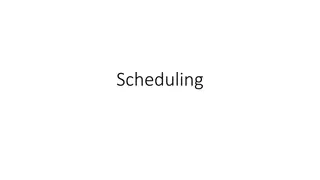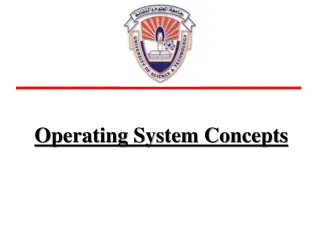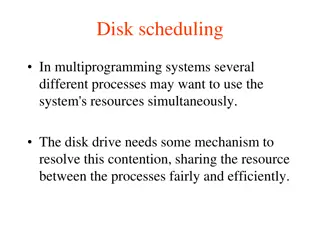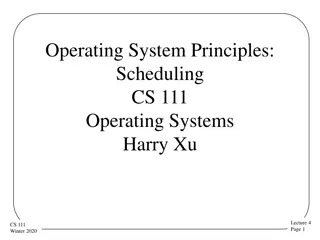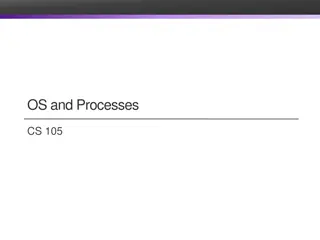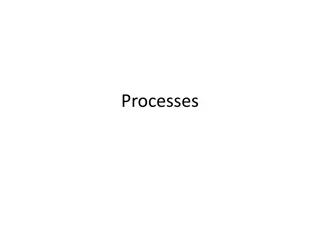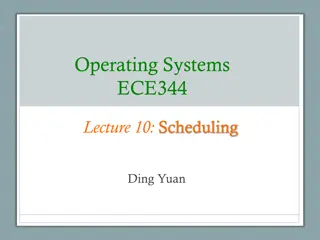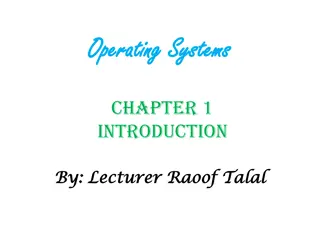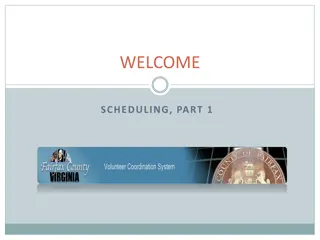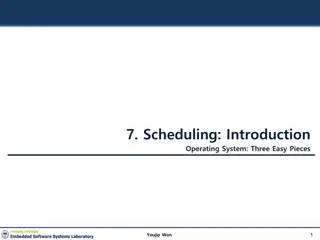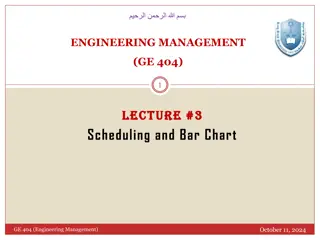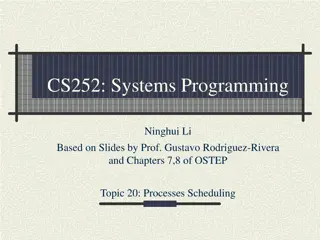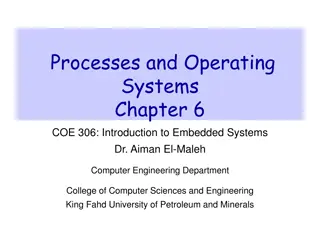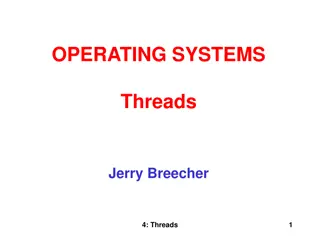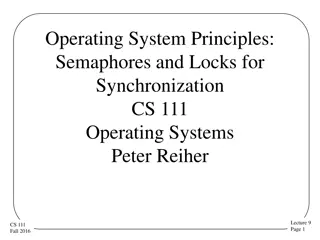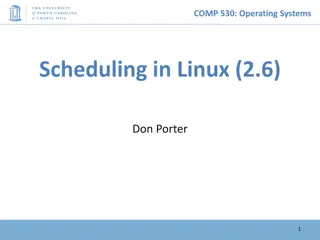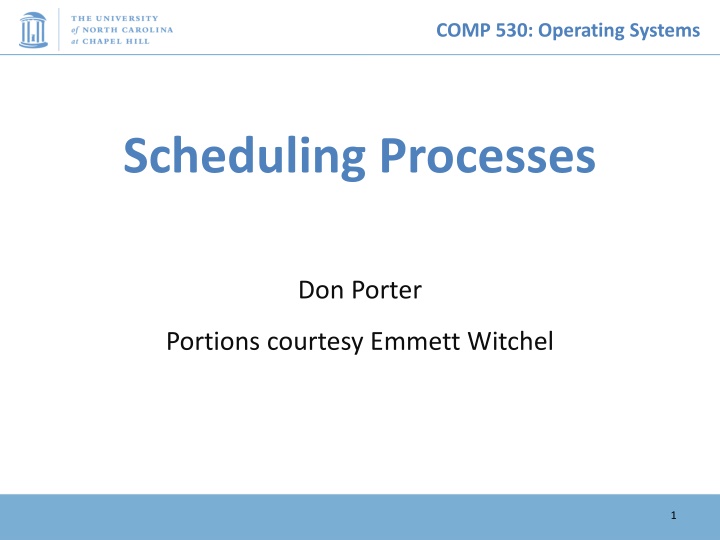
Operating Systems Scheduling Processes Overview
This content provides an overview of operating systems scheduling processes, focusing on the Process Control Block (PCB), scheduling decisions, scheduler function, evaluation criteria, scheduling policies, and goal considerations in CPU scheduling.
Download Presentation

Please find below an Image/Link to download the presentation.
The content on the website is provided AS IS for your information and personal use only. It may not be sold, licensed, or shared on other websites without obtaining consent from the author. If you encounter any issues during the download, it is possible that the publisher has removed the file from their server.
You are allowed to download the files provided on this website for personal or commercial use, subject to the condition that they are used lawfully. All files are the property of their respective owners.
The content on the website is provided AS IS for your information and personal use only. It may not be sold, licensed, or shared on other websites without obtaining consent from the author.
E N D
Presentation Transcript
COMP 530: Operating Systems Scheduling Processes Don Porter Portions courtesy Emmett Witchel 1
COMP 530: Operating Systems Processes (refresher) Each process has state, that includes its text and data, procedure call stack, etc. This state resides in memory. The OS also stores process metadata for each process. This state is called the Process Control Block (PCB), and it includes the PC, SP, register states, execution state, etc. All of the processes that the OS is currently managing reside in one and only one of these states.
COMP 530: Operating Systems Scheduling Processes The OS has to decide: When to take a Running process back to Ready Which process to select from the Ready queue to run next Ready Queue: Policy can be something other than First-in, First-out! 3
COMP 530: Operating Systems Scheduler The kernel runs the scheduler at least when a process switches from running to waiting (blocks) a process is created or terminated. an interrupt occurs (e.g., timer chip) Non-preemptive system Scheduler runs when process blocks or is created, not on hardware interrupts Preemptive system OS makes scheduling decisions during interrupts, mostly timer, but also system calls and other hardware device interrupts
COMP 530: Operating Systems Evaluation Criteria and Policy Goals? CPU Utilization: The percentage of time that the CPU is busy. Throughput: The number of processes completing in a unit of time. Turnaround time: The length of time it takes to run a process from initialization to termination, including all the waiting time. Waiting time: The total amount of time that a process is in the ready queue. Response time: The time between when a process is ready to run and its next I/O request. Fairness: ??
COMP 530: Operating Systems Scheduling Policies Ideal CPU scheduler Maximizes CPU utilization and throughput Minimizes turnaround time, waiting time, and response time Real CPU schedulers implement particular policy Minimize response time - provide output to the user as quickly as possible and process their input as soon as it is received. Minimize variance of average response time - in an interactive system, predictability may be more important than a low average with a high variance. Maximize throughput - two components 1. minimize overhead (OS overhead, context switching) 2. efficient use of system resources (CPU, I/O devices) Minimize waiting time - be fair by ensuring each process waits the same amount of time. This goal often increases average response time. Will a fair scheduling algorithm maximize throughput? A) Yes B) No
COMP 530: Operating Systems Different Process Activity Patterns CPU bound mp3 encoding Scientific applications (matrix multiplication) Compile a program or document I/O bound Index a file system Browse small web pages Balanced Playing video Moving windows around/fast window updates Scheduling algorithms reward I/O bound and penalize CPU bound Why?
COMP 530: Operating Systems Scheduling Policies Simplifying Assumptions One process per user One thread per process (more on this topic next week) Processes are independent Researchers developed these algorithms in the 70 s when these assumptions were more realistic, and it is still an open problem how to relax these assumptions. Scheduling Algorithms to Evaluate Today: FCFS: First Come, First Served Round Robin: Use a time slice and preemption to alternate jobs. SJF: Shortest Job First Multilevel Feedback Queues: Round robin on priority queue. Lottery Scheduling: Jobs get tickets and scheduler randomly picks winning ticket.
COMP 530: Operating Systems Policy 1: FCFS (First Come, First Served) The scheduler executes jobs to completion in arrival order. In early FCFS schedulers, the job did not relinquish the CPU even when it was doing I/O. We will assume a FCFS scheduler that runs when processes are blocked on I/O, but that is non-preemptive, i.e., the job keeps the CPU until it blocks (say on an I/O device).
COMP 530: Operating Systems FCFS Example and Analysis In a non-preemptive system, the scheduler must wait for one of these events, but in a preemptive system the scheduler can interrupt a running process. If the processes arrive one time unit apart, what is the average wait time in these three cases? Advantages: Disadvantages
COMP 530: Operating Systems Policy 2: Round Robin Run each process for its time slice (scheduling quantum) After each time slice, move the running thread to the back of the queue. Selecting a time slice: Too large - waiting time suffers, degenerates to FCFS if processes are never preempted. Too small - throughput suffers because too much time is spent context switching. Balance the two by selecting a time slice where context switching is roughly 1% of the time slice. A typical time slice today is between 10-100 milliseconds, with a context switch time of 0.1 to 1 millisecond. Max Linux time slice is 3,200ms, Why? Is round robin more fair than FCFS? A)Yes B)No
COMP 530: Operating Systems Round Robin Example (1) 5 jobs, 100 seconds each, time slice 1 second, context switch time of 0, jobs arrive at time 0,1,2,3,4 Completion Time (Wall clock time) Length FCFS Round Robin Wait Time = (Compl. Arrival exec time) FCFS Round Robin Job 1 100 2 100 3 100 4 100 5 100 Average
COMP 530: Operating Systems Round Robin Example (1) 5 jobs, 100 seconds each, time slice 1 second, context switch time of 0, jobs arrive at time 0,1,2,3,4 Completion Time (Wall clock time) Length FCFS Round Robin Wait Time = (Compl. Arrival exec time) FCFS Round Robin Job 1 100 100 0 2 100 200 99 3 100 300 198 4 100 400 297 5 100 500 396 Average 300 198
COMP 530: Operating Systems Round Robin Example (1) 5 jobs, 100 seconds each, time slice 1 second, context switch time of 0, jobs arrive at time 0,1,2,3,4 Completion Time (Wall clock time) Length FCFS Round Robin Wait Time = (Compl. Arrival exec time) FCFS Round Robin Job 1 100 100 496 396 0 2 100 200 497 99 396 Why is this better? 3 100 300 498 198 396 4 100 400 499 297 396 5 100 500 500 396 396 Average 300 498 198 396
COMP 530: Operating Systems Round Robin Example (2) 5 jobs, of length 50, 40, 30, 20, and 10 seconds each, time slice 1 second, context switch time of 0 seconds, all arrive at time 0 Completion Time (Wall clock time) Job Length FCFS Round Robin Wait Time = (Compl. Arrival exec time) FCFS Round Robin 1 50 2 40 3 30 4 20 5 10 Average
COMP 530: Operating Systems Round Robin Example (2) 5 jobs, of length 50, 40, 30, 20, and 10 seconds each, time slice 1 second, context switch time of 0 seconds, all arrive at time 0 Completion Time (Wall clock time) Job Length FCFS Round Robin Wait Time = (Compl. Arrival exec time) FCFS Round Robin 1 50 50 0 2 40 90 50 3 30 120 90 4 20 140 120 5 10 150 140 Average 110 80
COMP 530: Operating Systems Round Robin Example (2) 5 jobs, of length 50, 40, 30, 20, and 10 seconds each, time slice 1 second, context switch time of 0 seconds, all arrive at time 0 Completion Time (Wall clock time) Job Length FCFS Round Robin Wait Time = (Compl. Arrival exec time) FCFS Round Robin 1 50 50 150 0 100 2 40 90 140 50 100 Seriously, aren t these the same? 3 30 120 120 90 90 4 20 140 90 120 70 5 10 150 50 140 40 Average 110 110 80 80
COMP 530: Operating Systems Fairness Was the average wait time or completion time really the right metric? No! What should we consider for the example with equal job lengths? Variance! What should we consider for the example with varying job lengths? Is completion time proportional to required CPU cycles?
COMP 530: Operating Systems Policy 3: Shortest Job First (SJF) Schedule the job that has the least (expected) amount of work (CPU time) to do until its next I/O request or termination. I/O bound jobs get priority over CPU bound jobs. 19
COMP 530: Operating Systems Shortest Job First (SJF) Example Example: 5 jobs, of length 50, 40, 30, 20, and 10 seconds each, time slice 1 second, context switch time of 0 seconds, all arrive at time 0 , (Wall Clock Time) Job Length FCFS RR SJF Completion Time Wait Time (Compl. Exec Arrival) FCFS RR SJF 1 50 2 40 3 30 4 20 5 10 Average
COMP 530: Operating Systems Shortest Job First (SJF) Example Example: 5 jobs, of length 50, 40, 30, 20, and 10 seconds each, time slice 1 second, context switch time of 0 seconds, all arrivae at time 0 Completion Time Wait Time Job Length FCFS RR SJF FCFS RR SJF 1 50 50 150 150 0 100 100 2 40 90 140 100 50 100 60 Now that s what I m talking about! 3 30 120 120 60 90 90 30 4 20 140 90 30 120 70 10 5 10 150 50 10 140 40 0 Average 110 110 70 80 80 40
COMP 530: Operating Systems Shortest Job First Works for preemptive and non-preemptive schedulers. Preemptive SJF is called SRTF - shortest remaining time first. Advantages? Free up system resources more quickly Disadvantages? How do you know how long something will run? Academic scheduler: Useful to decide if a good idea
COMP 530: Operating Systems Idea: Use the Past to Predict the Future Intuition: Assign a dynamicpriority to each task Higher priority processes more likely to be scheduled (if ready) Assign dynamic priority based on behavior during last few quanta Raise dynamic priority frequently process blocks on I/O Probably latency-sensitive (e.g., word processer, web server) When runnable, will probably do a little work and block again on more I/O Lower dynamic priority of processes that use all of their quantum Probably CPU-bound Adaptive: priorities change when process changes behavior (e.g., switching from I/O to CPU-intensive)
COMP 530: Operating Systems Policy 4: Multi-Level Feedback Queues Approximate SJF: multiple queues with different priorities. OS uses Round Robin scheduling at each priority level, running the jobs in the highest priority queue first. Once those finish, OS runs jobs out of the next highest priority queue, etc. (Can lead to starvation.) Round robin time slice increases exponentially at lower priorities. Good for CPU-bound jobs to be lower priority (if they don t starve)
COMP 530: Operating Systems Policy 4: Multi-Level Feedback Queues Adjust priorities as follows (details can vary): 1. Proc starts in the highest priority queue 2. If proc s time slice expires, drop its priority one level. 3. If proc s blocked with remaining time slice, increase its priority one level, up to the top priority level. ==> In practice, CPU bound procs drop like a rock in priority and I/O bound procs stay at high priority
COMP 530: Operating Systems Fairness SJF is optimal, but unfair Improving fairness means giving long jobs a fraction of the CPU when shorter jobs are available Will degrade average waiting time. Possible solutions: Give each level queue a fraction of the CPU time. This solution is only fair if there is an even distribution of jobs among queues. Adjust the priority of jobs as they do not get serviced (Unix originally did this.) Avoids starvation Average waiting time suffers when the system is overloaded because all the jobs end up with a high priority.
COMP 530: Operating Systems Policy 5: Lottery Scheduling Give every job some number of lottery tickets. On each time slice, randomly pick a winning ticket. On average, CPU time is proportional to the number of tickets given to each job. Assign tickets by giving the most to short running jobs, and fewer to long running jobs (approximating SJF). To avoid starvation, every job gets at least one ticket. Degrades gracefully as load changes. Adding or deleting a job affects all jobs proportionately, independent of the number of tickets a job has.
COMP 530: Operating Systems Lottery Scheduling Example Example: Short jobs get 9 tickets, long jobs get 1 tickets each. # short jobs / # long jobs 1/1 % of CPU each short job gets 90% % of CPU each long job gets 10% 0/2 2/0 10/1 1/10
COMP 530: Operating Systems Lottery Scheduling Example Example: Short jobs get 9 tickets, long jobs get 1 tickets each. # short jobs / # long jobs 1/1 % of CPU each short job gets 90% % of CPU each long job gets 10% 0/2 0% 50% 2/0 10/1 1/10
COMP 530: Operating Systems Lottery Scheduling Example Example: Short jobs get 9 tickets, long jobs get 1 tickets each. # short jobs / # long jobs 1/1 % of CPU each short job gets 90% % of CPU each long job gets 10% 0/2 0% 50% 2/0 50% 0% 10/1 1/10
COMP 530: Operating Systems Lottery Scheduling Example Example: Short jobs get 9 tickets, long jobs get 1 tickets each. # short jobs / # long jobs 1/1 % of CPU each short job gets 90% % of CPU each long job gets 10% 0/2 0% 50% 2/0 50% 0% 10/1 9/91=~9.8% 1/91=~1% 1/10
COMP 530: Operating Systems Lottery Scheduling Example Example: Short jobs get 9 tickets, long jobs get 1 tickets each. # short jobs / # long jobs 1/1 % of CPU each short job gets 90% % of CPU each long job gets 10% 0/2 0% 50% 2/0 50% 0% 10/1 9/91=~9.8% 1/91=~1% 1/10 9/19=~47% 1/19=~5.3%
COMP 530: Operating Systems Summary of Scheduling Algorithms FCFS: Not fair, and average waiting time is poor. Round Robin: Fair, but average waiting time is poor. SJF: Not fair, but average waiting time is minimized assuming we can accurately predict the length of the next CPU burst. Starvation is possible. Multilevel Queuing: An implementation (approximation) of SJF. Lottery Scheduling: Fairer with a low average waiting time, but less predictable. Our modeling assumed that context switches took no time, which is unrealistic.


